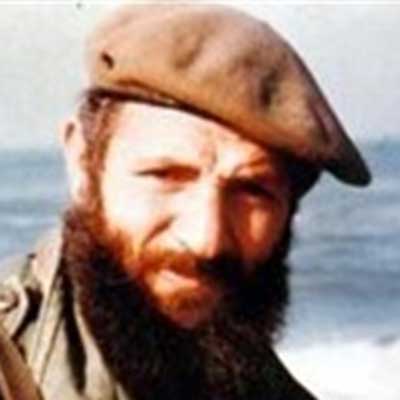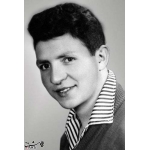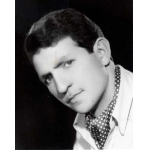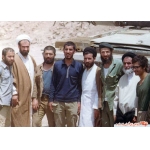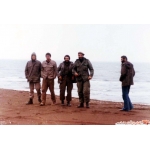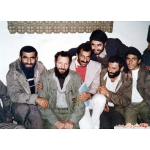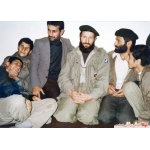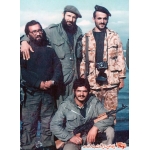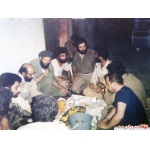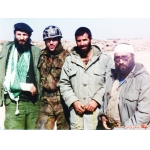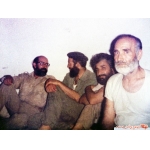Hashemi, Seyyed Mojtaba
Afsaneh Danesh Raftar
264 بازدید
Seyyed Mojtaba Hashemi Ghandi (1940–1985) was the first commander of the Central Islamic Revolution Committee of Tehran and the leader of the Fadaiyan-e Islam Group during the Iran-Iraq War. He was assassinated on May 18, 1985, in Tehran’s Vahdat-e Eslami Street by members of the Mojahedin-e Khalq Organization (Monafiqeen).
Seyyed Mojtaba Hashemi was born on November 4, 1940, in the Shapour neighborhood of Tehran. He was the third child of a religious family. His grandfather, Seyyed Hashem Hashemi Ghandi, founded the Ghandi Mosque in Muhammadiyeh Square. He was a prominent sugar merchant in Tehran, known for his piety and dedication to knowledge and culture. After completing high school, Seyyed Mojtaba joined the Army and became a member of the Special Force due to his strong physique. However, disillusioned by the situation in the Army and the nature of the Pahlavi regime, he left the military and started his own business. His father owned several shops in the Bazaarcheh Nou, and Seyyed Mojtaba set up a glassware shop next to his father’s herbal store.[1]
On June 5, 1963, Seyyed Mojtaba and some friends joined Imam Khomeini’s Islamic movement. He was active in Tehran and neighboring provinces, distributing leaflets and cassette tapes containing Imam Khomeini’s statements, speeches, and photographs. During the early days of the victory of the Islamic Revolution, he changed his shop into a cooperative to provide essential goods to the people at a lower price.[2]
On February 1, 1979, when Imam Khomeini (ra) returned to Iran, Seyyed Mojtaba participated in the historic welcoming committee. After the Islamic Revolution, he focused on combating remnants of the Pahlavi regime. He organized revolutionary forces in Tehran’s District 9 and established the District 9 Islamic Revolution Committee. His efforts in capturing fugitives and restoring order earned him respect among the local community. He gathered revolutionary forces and formed one of Tehran’s strongest committees.
Following the outbreak of tensions in Kurdistan, Hashemi and some members of the District 9 Committee, in response to Imam Khomeini’s call for general mobilization, went to the west of Iran to help liberate and secure the area. Shortly after the Iran-Iraq War began, Seyyed Mojtaba Hashemi and his comrades voluntarily traveled to southern Iran and stayed at the Fadaiyan-e Islam School in Abadan. Therefore, the first irregular military force to confront Iraq’s invasion was formed in Abadan and Khorramshahr, known as the Fadaiyan-e Islam Group.[3]
The Supreme Leader of the Islamic Revolution, who was the then-representative of Imam Khomeini (ra) and Tehran’s Friday Prayer Leader, went to Abadan to meet the Fadaiyan-e Islam Group. Admiring their determination and efforts he said, “We have spoken of the Fadaiyan-e Islam in various places and praised you, but now we see you are much more energetic and capable than we described—determined, committed, and dynamic. Your name suits you—Fadaiyan-e Islam (Devotees of Islam)”. Seyyed Mojtaba said, “There are pictures of Ayatollah Khamenei in all trenches, and with that love, we support him”. Then, Ayatollah Khamenei replied, “If you have our pictures in your trenches, then in our hearts—which are God’s trenches—you all have a place, God willing”.[4]
The Mojahedin-e Khalq Organization made several assassination attempts on Hashemi, but he managed to survive because he was always carrying a gun. In one instance, they smeared tar on his door lock to trap him when unlocking it and then kill him. However, he took cover in a small ditch near his house and shot at his attackers. In another attempt, they kidnapped his wife, but she disarmed them.
Hashemi frequently helped the people in various ways. During the anniversary of the victory of the Islamic Revolution, he sold scarce goods in his clothing shop at prices lower than their actual value. He turned his store into a cooperative named Vahdat-e Eslami and provided scarves and shoes for needy students.
On the day of his assassination, while the shop was closed, several members of Monafiqeen approached Seyyed Mojtaba Hashemi, claiming they had come from a far place and needed scarves and other clothes. Unarmed, he raised the shop’s shutter and opened the door. Then, they entered and shot him from behind several times.
On May 18, 1985, Seyyed Mojtaba Hashemi was assassinated by the members of the Mojahedin-e Khalq Organization (Monafiqeen) and attained martyrdom.[5]
[1] Fakour, Asghar, Agha Seyyed Mojtaba (Mr. Seyyed Mojtaba), Tehran: Shahid, 1391, Pp. 19 and 20.
[2] Samadi, Muhammad Ali, Setaregan-e Aseman-e Gomnami (The Anonymous Stars of the Sky), Tehran: Farhangsaray-e Andisheh, 1378, p. 180; Kazemi, Jafar, Panjeh Dar Panjeh Raeis Jomhur (With the President), Tehran: Fatihan, 1395, p. 27.
[3] Samadi, Muhammad Ali, Setaregan-e Aseman-e Gomnami (Anonymous Skys of the Star), Pp. 180 and 181.
[4] Ibid, p. 181; Kazemi, Jafar, Panjeh Dar Panjeh Raeis Jomhur (With the President), Pp. 11–13.
[5] Kazemi, Jafar, Panjeh Dar Panjeh Raeis Jomhur (With the President), Pp. 171 and 172; Fakour, Asghar, Agha Seyyed Mojtaba, p. 16.


